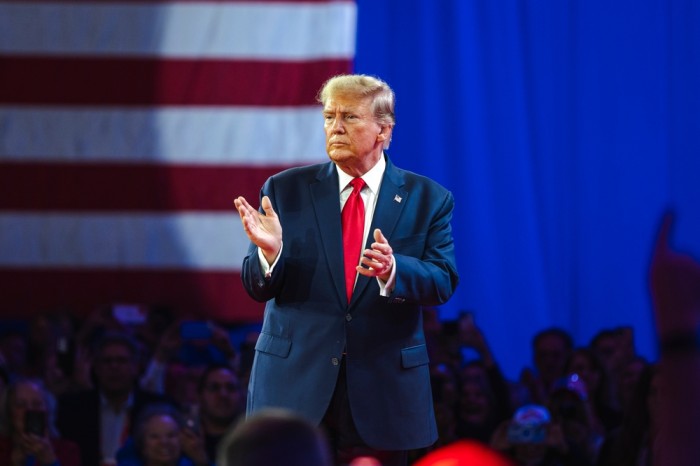Global tariffs, trade wars, and uncertainty: Navigating a market storm

Trump's aggressive tariff measures have rattled global markets, intensifying fears of trade retaliation, recession, and economic repercussions.
Trump has fired successive shots in the global tariff war with a 10% tariff on all imports from many countries, slapping hefty duties on China (34%), the EU (20%), Japan (24%), Taiwan (32%), Vietnam (46%), India (26%), Korea (25%), and Australia (10%).
Last week, a retaliatory move from China against the tariffs imposed by U.S. President Donald Trump added fuel to the fire, increasing the likelihood of a protracted trade war and exacerbating concerns about the potential damage to the global economy.
A historic market slide
The impact of the rising trade tensions was immediately felt on the global stock markets. In the U.S., all three major stock indexes plummeted more than 5%, with the S&P 500 falling nearly 6%. This marked the worst week for the U.S. stock market since 2020, capping off a tumultuous period for investors. The UK's FTSE 100 saw a dramatic decline of almost 5%, its steepest drop in five years, while other global markets, including those in Germany, France, and Asia, also experienced significant losses.
The Australian share market is following, with the benchmark ASX 200 index plunging more than 6% at the open, as the local currency falls below 60 US cents.
In just minutes, the ASX saw a staggering $160 billion wiped off its value, with the ASX 200 index plummeting by 461.40 points (or 6.02%) to land at 7,206.40. The sharp decline marked a challenging start to the trading week, raising concerns among market participants.
The Australian dollar also took a hit, reaching a low of 59.92 US cents on opening—its weakest point since a brief dip in April 2020. This drop in currency value has compounded fears of ongoing market volatility and possible repercussions for the Australian economy.
After a period of strong performance earlier in the year, the S&P 500 ended the quarter on a sour note. The tech-heavy Nasdaq suffered a sharp fall, fueled by concerns about the growing competition in the artificial intelligence (AI) sector. While value stocks outperformed growth stocks during the quarter, small-cap stocks underperformed their large-cap counterparts.
Despite starting the quarter with optimism, U.S. stocks ended it on a down note, trailing behind their global counterparts. This downturn is primarily attributed to a combination of factors: uncertainty about the economy, increasing competition in the AI space, and the ongoing impact of tariffs under the new U.S. presidential administration. While the S&P 500 reached record highs early in the quarter, it ended the period down for the year as of late March.
Global economic uncertainty
The effects of U.S. tariffs are being felt worldwide, and experts are starting to question the longer-term consequences of these policies. During the quarter, global equities, as measured by the MSCI All Country World Index, rose by only 0.4%, weighed down by the underperformance of U.S. stocks. Meanwhile, developed international stocks outperformed the U.S., with the MSCI World ex USA Index rising by 9.3%, and the MSCI Emerging Markets Index climbing 5.7%.
The bond market also saw shifts, with U.S. Treasuries gaining and pushing the benchmark 10-year yield below 4.5%. The Bloomberg U.S. Aggregate Bond Index, a broad measure of U.S. bonds, increased by 2.6%, while global bonds saw modest gains as well.
While U.S. Treasury Secretary Scott Bessenthas called for patience and urged countries not to retaliate, many observers believe the international community will not sit idly by. Trump’s tariff measures have been unexpected and have raised alarms about the U.S. potentially entering a recession.
Short term vs long term impact
Economic experts like AMP’s Shane Oliver argue that Trump's tariffs could harm the U.S. economy in the long term, leading to a higher chance of a recession. While some have framed these tariffs as a corrective measure to balance trade deficits, the actual economic outcome could be much more damaging. The Organization for Economic Cooperation and Development (OECD) has warned that a 10% increase in tariffs could reduce global GDP by 0.3% over three years, while inflation could rise by an average of 0.4% annually.
Australia has been somewhat insulated from the worst effects of the tariffs, particularly compared to other nations. While Australia’s relationship with the U.S. is being strained, the direct impact of Trump’s tariffs on Australian exports is expected to be limited. However, economists caution that the indirect effects, particularly from a potential slowdown in China’s economy, could have more significant consequences for Australia’s exports.
David Bassanese, chief economist at Betashares, noted that while Australia has “gotten off lightly,” the real threat comes from slower global growth, especially in key trading partners like China, Europe, and Canada. This slowdown could reduce demand for Australian exports, which could, in turn, weigh on the country's economy.
"Investors must now wait to see how policymakers react," said Chris Kushlis, chief emerging markets macro strategist at T. Rowe Price. "But while they wait, global markets are already making their moves."
While U.S. stocks have already experienced a 10% dip, many experts, including Oliver, believe a deeper correction—15% or more—is likely. If that happens, the pressure on President Trump to reconsider his tariff strategy may increase, potentially leading to market-friendly policies like tax cuts or deregulation. However, given Trump’s unpredictable nature, the future remains uncertain.
As markets continue to react to the shifting economic landscape, investors are being urged to stay calm and avoid making hasty decisions based on short-term volatility. The key takeaway is that market resilience during times of uncertainty and economic upheaval is often stronger than it appears at first glance.
The threat of stagflation and economic contraction
Wes Crill, PhD Senior Client Solutions Director and Vice President at Dimensional Fund Advisors said one of the key concerns arising from the escalating tariff talks is the possibility of stagflation—a situation where inflation rises while the economy contracts.
Historically, the U.S. has experienced instances of stagflation, but surprisingly, even during those times, the U.S. stock market still delivered positive real returns in the majority of cases. Research shows that since 1930, the U.S. stock market posted positive real returns in 9 out of 12 years when inflation and GDP contraction occurred simultaneously.
Despite concerns over the economy, long-term investors are advised not to make knee-jerk decisions based on short-term volatility. Markets tend to price in risks well in advance, and during Donald Trump’s first term, U.S. and Chinese equities outperformed the broader global market, suggesting that investors who stay the course may still see positive returns even amid economic uncertainty.
“This is another example demonstrating how concerns over the economy shouldn't drive portfolio decisions,” Crill said.
“Predictions about the direction of the economy are continuously forming, but the market itself remains the best predictor of the future. That means market prices are set to levels to deliver positive expected returns even amid concerns over future economic outcomes.”





